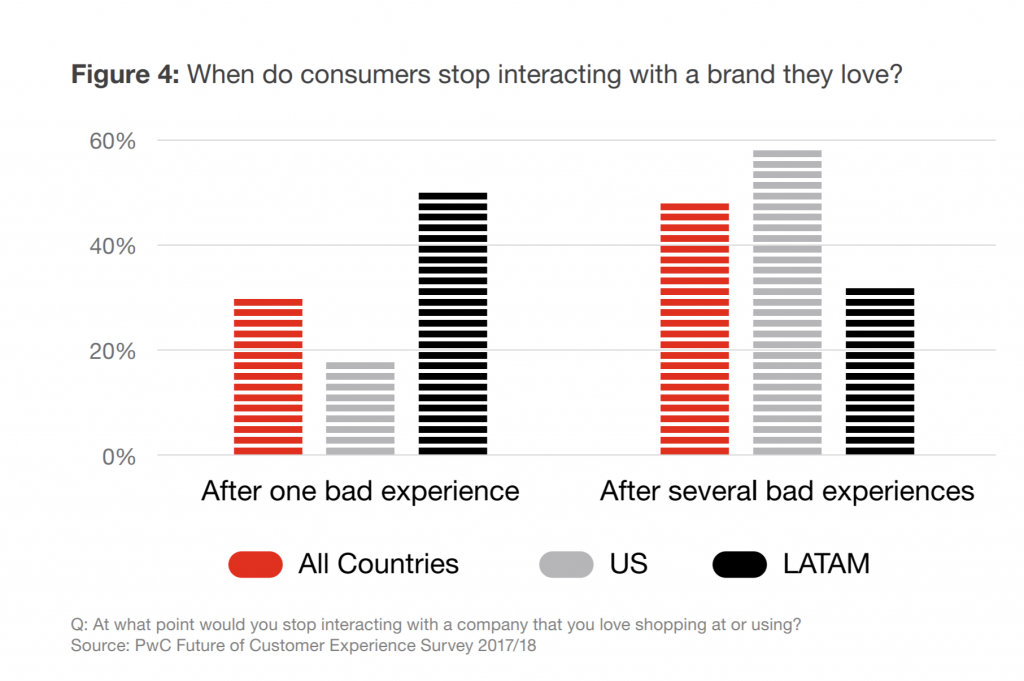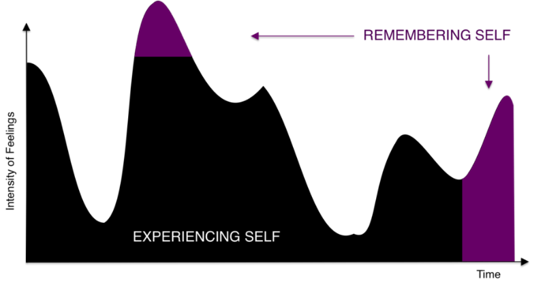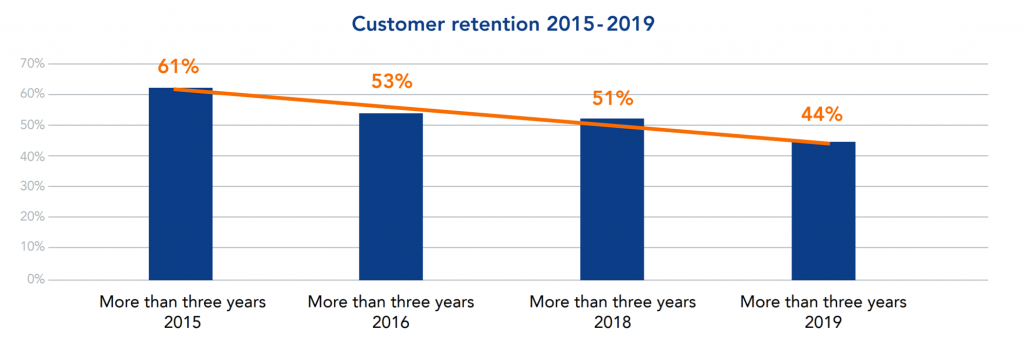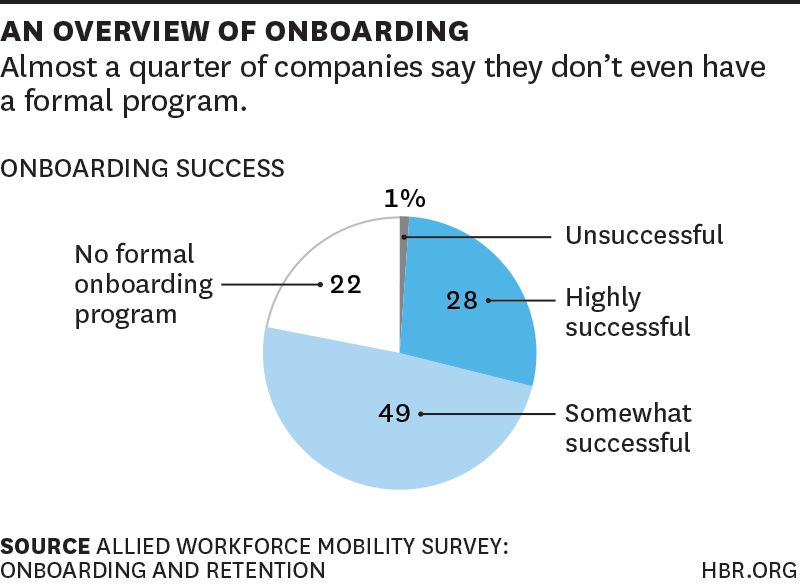
The core principle that drives Emotive CX is that customer needs and expectations span both the functional and emotive. As a result, customer decisions, memories and perceptions of an organisation are strongly influenced by how they feel.
A great deal of this emotional influence takes place at a sub conscious level. According to Harvard Business School professor Gerald Zaltman, 95% of our purchase decision making takes place subconsciously. It’s what we would call an impulse purchase; at the time it just felt right, even if we cannot explain it ourselves afterwards. In fact, the whole of the advertising world is founded on scratching this impulse.

We also know that customers are emotionally triggered around the quality of service they experience when interacting with organisations. In Latin America (LATAM), 50% of consumers will even quit a brand they love after just one bad experience.
It’s well worth testing how far this reflects your own customer behaviour. One thing is certain though. Disrupter brands are continuously resetting expectations.
Monzo bank is a rising star in this respect.
“Their innovation has set a new benchmark for what customers expect from their bank, and established players are having to rise to the challenge” Richard Little, head of challenger banking at KPMG UK.
Organisations now find themselves in an arms race to match not only the standards of direct competitors but any innovation their customers become aware of. Of course, news travels lightning fast these days across social feeds and messaging apps.
The six month long course I’m running helps organisations design new end to end management capability in Emotive CX. A core premise is that loyalty is either strengthened or weakened by the emotive state a customer is left in at the end of any interaction. Customer value grows, stagnates or is lost on that basis.
Why Does This Matter To EX?
The answer is obvious once we consciously register that a customer and an employee is one and the same person with the same impulses, expectations and behaviours. Therefore finding, winning and increasing the value of customers and employees have many crossover points and common moments of truth.
Take listening as an example. Both customer and employee feedback drive commercial success. According to the Organisational Fitness Report by Qlearsite “Organisations that listen to their people are 4.6x more likely to have high growth”.
Of course, this is not a new story.
The connection between customer and employee experience is widely accepted and many organisations now recognise they need to be as mindful of their Glassdoor scores as much as their NPS scores. To underline the point, the 2019 Nunwood index states that UK companies who lead in CX typically have 1.5 times as many engaged employees as CX laggards.
However, the reason why Emotive CX has attracted so much positive attention since its launch early 2019 is its emphasis on emotion. Organisations are always going to be challenged in how they strike the right balance between being open to individual human experience and scaling a standard response through insight programmes, journey redesign and a few smart behavioural nudges.
The same can be said of employee experience. All the trappings are on display. Onboarding, buddies and pulse surveys. But people can still feel untouched and hollow around really feeling motivated, recognised and included. Understanding people through the lens of emotion can unlock insights that make all the difference. As Maya Angelou is rightly appreciated for reminding us;
“People don’t always remember what you say or even what you do, but they always remember how you made them feel.”
We Remember Highlights
Daniel Kahneman, the behavioural economist, has helped popularise the notion that we process our reality in a highly selective way.
Human memory banks are finite. This is significant because a key function that memory provides is ongoing guidance on how to react. Given that our brain’s core mission is to keep us out of harm’s way, it naturally prioritises anything that seems a threat to our wellbeing: physical, cognitive or emotional.

This results in a cherry-picking approach which Kahneman calls the ‘remembering self’. In contrast to the totality of what we experience through a typical day, a very small fraction of experiences is retained.
These tend to be harvested from event highlights – beginnings, endings and any significant outliers during an experience.
They then form the basis of what is subsequently recalled which becomes the way we believe an experience happened. We also forget that we are more sensitized to threats to our well-being and so the negatives are more likely to be committed to memory.
Emotive CX is all about taking the sting out of negative feelings by finding pathways to appropriately positive emotive outcomes as the basis of what is then remembered about a brand’s performance.
In this sense, each unfolding episode in the customer lifecycle is full of potential emotive pitfalls. For instance, we know that people are especially sensitive to any gaps between what they signed up for (the promise) and how things are (the delivery) immediately after making their choice.
Buyer’s remorse is a well-known customer feeling. Can we recognize the same human reaction in the employee lifecycle? Here are some US statistics from a Harvard Business Review article that suggest so.
- Nearly 33% of new hires look for a new job within their first six months on the job. (Among Millennials, that percentage is even higher … and it happens earlier.)
- 23% of new hires turn over before their first anniversary.
- It typically takes eight months for a newly hired employee to reach full productivity.
- The organizational costs of employee turnover are estimated to range between 100% and 300% of the replaced employee’s salary.
The lack of care managing these expectation gaps simply does not make sense economically. Anymore than it would if these were statistics around customer churn.
Loyalty Needs Constant Attention
While some industries such as consumer insurance still seem willing to lose customers at alarming rates (ever noticed how premiums are raised after the first year?), other sectors like Enterprise Technology now use the role of customer success managers to help new customers extract value from their purchases. They have recognised that in the SaaS world it is all too easy for customers to move on.
Investing in proactive care and education has been the industries recognition that customers have greater choice these days. It’s a behaviour that is clearly shown in this global survey of 34,000 adults in 18 countries (source: Engagement in the Always On Era).

It also seems we are becoming less loyal to brands as both customers and employees. Here is a telling observation from well-known CCO mentor Jeanne Bliss:
“Most companies I’ve seen don’t do a review of a new hire until one year. But the average tenure at jobs right now is about four and a half years. One year is already 22% of the time an employee will work with you. Let’s do more 90 day reviews and figure out the “repeat purchase intention” of your employees — namely, do they plan to stay with you? It’s very important. You can’t keep reinventing and rebuilding your team”
Of course, she is right. And given the expense, effort and multiple hurdles employers subject themselves to in order to get the right people through the door, it is beyond bonkers that the ball is then immediately dropped.
The wrong mindset seems to be at the core of the problem. Companies simply don’t recognize the need to set employees up for success. Here’s another interesting observation.
Many companies approach onboarding as something that stops “when all paperwork is signed and the employee’s first day is complete,” said Ben Peterson, CEO of BambooHR,

It seems some companies don’t even attempt to formally onboard new hires. Yet this is the point when emotive expectations are at their highest and the need to feel included in the new organisation is most keenly felt.
How we onboard people frames the rest of the relationship. It’s not a single event. It’s an ongoing strategy.
Of course, there are many other moments that will matter across the employee lifecycle. Some are standard organisational events;
- Being performance managed in a supportive meaningful way
- Being able to add new skills and experience to stay relevant in an ever-changing job market
- Receiving a promotion and being mentored to succeed
- And, of course, the ongoing advocacy value of being finally and positively offboarded
The memory of how each is dealt with directly impacts that person’s future value to their organisation. These are powerful motivators when done right. But they can also cripple enthusiasm and ambition when done without an empathetic awareness leaving negative memories to feed future decisions and perceptions.
Then there are life events. These are central to the employee but can be easily missed in terms of their emotive importance by the organisation. Marriage, parenting, schooling, moving home, coping with family and personal illness and other stresses.
How these moments of truth are dealt makes all the difference. According to the Nunwood report on CX leaders in the UK, the main differentiator over the last 12 months has been the impact of employee engagement programmes among the most successful of the brands analysed.
First direct, Monzo, Lush, Lakeland, Richer Sounds and John Lewis Finance have topped the rankings, based on the views of over 13,000 UK consumers. It is no co-incidence that each of those brands also have highly commended employee engagement practices in place.
As the report concludes – “organisations that achieve leadership have put emotional connections at the centre of a chain which starts with culture and ends with growth”. It goes on to explain that “the employee experience should directly align to the customer experience. Firms need to design their employee experiences as methodically as they design their customer experiences, at both the strategic level and the day-to-day level. Increasingly, this is done through the design of employee journeys.”.
In Conclusion
Keeping customers and employees is the same challenge. If we talk about customer obsession, we should be talking about employee obsession in the same breath. Growing customer value needs the delivery of promises made, backed up with relevant input to support their success. The same goes for employee value. Neither will tolerate being ignored or taken for granted when they are so many other choices within view.
There is clear upside when organisations get it right. Customers stay longer than average. So do employees. However, the experience economy we are now all bathed in means the bar is high and continues to rise.
Most of us need to up our game. Part of this is to recognise that at the heart of experience management is emotion. Emotionally literate organisations are more likely to understand what matters to people and how emotion influences their behaviour and decisions.
A couple of practical suggestions to end with.
- Check out the planning course on Emotive CX for Customer Interaction
- Find out more about employee experience platforms.These are central to the way organisations grow employee value and keep them loyal for longer. That’s because they address the emotive needs of recognition, contribution and challenge. I prefer LearnAmp.




